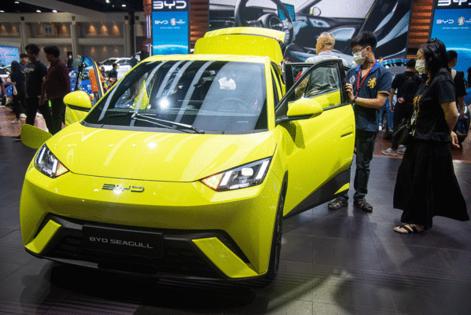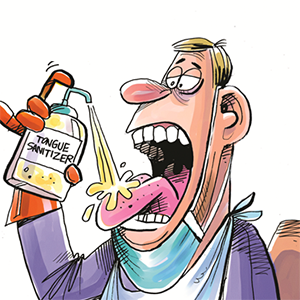Vehicle prices in China are spiraling down. What that means for tariffs
Published in Business News
Prices of vehicles in China are in a downward spiral, say experts who expect the circumstances to usher in industry consolidation and create opportunity for legacy automakers while tariffs are in place.
The average car retail price in China has fallen nearly 20% in the past two years, with the cuts accelerated for electric vehicles and other alternative-powertrain models, according to a report from financial services firm Nomura, citing data from Autohome Research Institute. Intense competition among roughly 150 brands in China in a market whose growth has slowed has led to price cuts, contributing to profit declines and companies looking to exports as the industry battles overcapacity.
Tariffs in North America and Europe, however, have challenged expansion globally. The circumstances have put the Chinese government on edge. That's why Bank of America analyst John Murphy likened the circumstances to declining prices in the U.S. market prior to the bankruptcies of General Motors Corp. and Chrysler Corp. in 2009. During the 2007 to 2009 recession, new U.S. vehicle sales fell by almost 40%, according to the Federal Reserve Bank of St. Louis.
"You could think back to the U.S. market from 2001-2009," he said at an Automotive Press Association event. "And what you're seeing in the Chinese market is an eventuality of the market collapsing under its own stress of this price hit. We all know, once you start the negative price spiral, it's almost impossible to pull out."
The average car price in China is around $22,900 (165,000 yuan). BYD Co. Ltd., the world's largest EV maker, announced discounts of 30% or more on 20 models in late May. Its budget-friendly electric Seagull compact car saw its starting price drop to $7,750 (55,800 yuan).
Those price points threaten to undermine legacy automakers. Tariffs offer the chance for U.S. companies to catch up if they move quickly, but the United States shouldn't welcome the selling of Chinese brands here until consolidation happens there, Murphy said.
"There's many reasons to have large tariffs on Chinese products and Chinese vehicles in the U.S. market," he said. "It's likely an eventuality. They will be here at some point. But you really want to see that rationalization of that market curve before you open up the doors."
When that could happen remains unclear. Anything in China really is "unprecedented," given the more than 31 million-vehicle market, said Tu Le, managing director of consulting firm Sino Auto Insights.
"I didn't think it would last this long," he said about the downward pricing pressure. "I still don't see an off-ramp, not through 2025."
Supporting the system is the size of the market in addition to overcapacity that offers the opportunity for expansion overseas. Chinese brands are exporting vehicles to other countries in Asia, South America, Mexico and Europe. Subsidies and the Chinese government's willingness, even at the provincial level, to step in and help to avoid plant closures also has elongated the process.
The Chinese government has classified the problem as "involution" — a term originally used to describe a culture of overwork and burnout among young people in the country — referring to intense competition that doesn't lead to positive results.
A news release on a May meeting of the Expert Advisory Group of the State Council Anti-Monopoly and Anti-Unfair Competition Commission in China concluded: "It is necessary to closely center on the Commission's work deployment, tightly grasp key tasks such as accelerating the construction of a unified national market, comprehensively rectifying 'involutionary' competition, and strengthening competition regulation and enforcement."
Manufacturers from BYD to state-backed Guangzhou Automobile Group last month said they would shorten payment terms for suppliers, who'd been facing delays in getting paid. The China Iron and Steel Association just before had said recent price cuts were affecting operations of companies up the supply chain.
"That's acknowledgment that the system is straining," Le said. "When the government and the industry says, 'This can’t last much longer,' and then competitors are pointing fingers at each other, that is a telltale sign."
He added: "I am fearful that there is some innocuous supplier of some key component that's strained, and it kind of freezes the supply chain."
The difference in China, however, said Michael Dunne, a former General Motors Co. executive-turned-CEO of consulting firm Dunne Insights, is that although GM and Chrysler got one-time bailouts from the United States, companies in China continuously are being bailed out by the government. It's allowed the country to dominate industries like rare-earth minerals, drones, solar panels and shipbuilding.
"Companies don't tend to go under," Dunne said. "In this case, they want to utterly dominate the global automotive industry. They have a lot of tolerance for pain."
People have predicted consolidation in China's automotive industry since the 1990s, but there's been proliferation, Dunne said. Now, the United States' leverage is access to its large and wealthy market.
"It'd be foolish for us not to use that leverage," Dunne said. It's clear why: Utilization of assembly plants in China last year was about 50%. That means there is a lot of room to supply big markets like the United States.
"That's not sustainable, hence the price war pressure," Le said. "There are too many companies, and so we need consolidation and for the bad companies to go away. That’s not happening fast enough."
That might just be the only thing in China's automotive industry not moving fast enough. Launching new platforms within 18 months, filing dozens of new patents every day and driving cost reductions through innovation, Chinese brands are leading legacy automakers, who need to move faster in product development, launches and innovation, said Terry Woychowski, president of automotive at teardown and benchmarking firm Caresoft Global Technologies Inc.
"You take advantage of this tariff as a timeout and get your act together," he said at a recent Society of Automotive Analysts event. "Take advantage of the fact that they're going to keep these at bay a little bit to give you the time to go through your development process and create vehicles that can compete toe-to-toe."
He suggested a "skunk works"-style project, a reference to a special team at defense contractor Lockheed Martin Corp. that was separated and given special freedoms in an effort to innovate.
Ford Motor Co. has a "skunkworks" team in California working on designing its next-generation EVs expected to be as low in cost as $30,000. The Dearborn automaker has said a new electric commercial van will launch in 2026 and a midsize and full-size electric truck in 2027.
In China itself, the company has emphasized the country as a manufacturing hub with its joint-venture partners for export of vehicles to places like South America, Asia and elsewhere.
"China's passenger vehicle industry continues to evolve with rapid rollout of new offerings and intense pricing competition," Ford spokesperson Anderson Chan said in a statement. "Ford's strategy to succeed in China includes working with local partners to strengthen business efficiencies and bring to market desirable vehicles tailored for the needs of Chinese customers and build on the trust in Ford's brand."
General Motors Co. restructured its Chinese business last year. Spokesperson George Svigos said the Detroit automaker is working with JV partner SAIC Motor to make the business there profitable and sustainable. For the past three quarters, GM has gained market share there with about half of its sales in new-energy vehicles, which includes all-electric and plug-in hybrid models. It will add extended-range EVs in the future, and all launches this year have at least one new-energy option.
Met with uneven demand in the United States for EVs, however, Ford and GM here have flipped plants once reserved for all-electric products to support gas- and diesel-powered production. Ford next year will build Super Duty pickups at its idled Oakville Assembly Complex in Ontario instead of a three-row electric SUV it has scrapped. GM last month announced a $4 billion investment in its Orion Township plant as well as sites in Fairfax, Kansas, and Spring Hill, Tennessee.
The companies, however, need to be focused on products that can take on Chinese brands in markets around the world — beyond the trucks and SUVs they rely on for profit in the United States, Dunne said.
"It doesn't have to be the lowest-cost vehicle, but it needs to be competitive when it comes to price," he said. "We've lost that magic in Detroit. We are not competing globally anymore, and so we're at risk of losing it all."
©2025 www.detroitnews.com. Visit at detroitnews.com. Distributed by Tribune Content Agency, LLC.












Comments